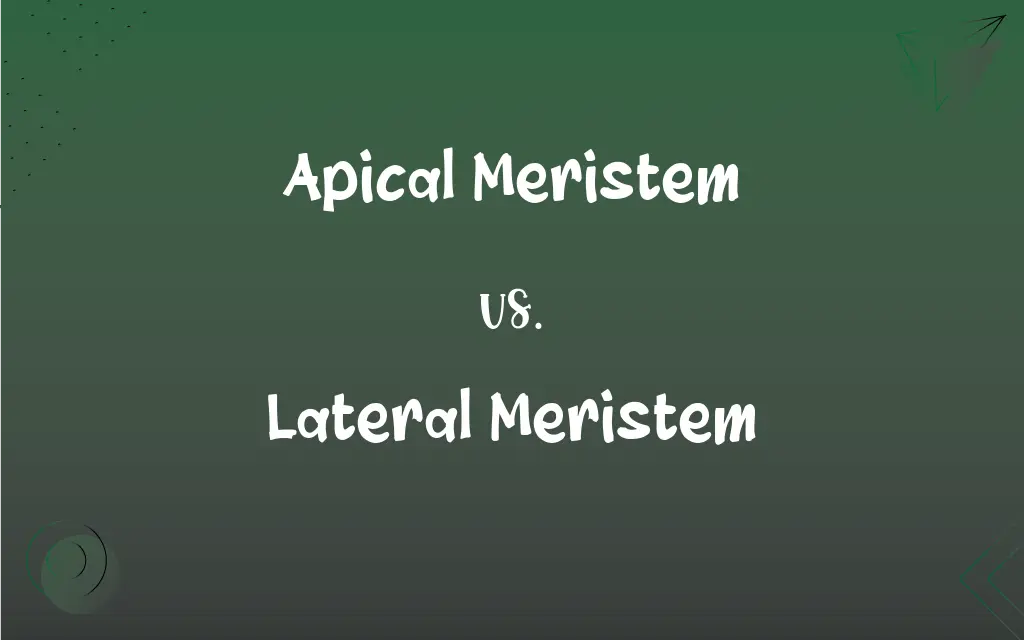Apical Meristem vs. Lateral Meristem: What's the Difference?
Edited by Aimie Carlson || By Harlon Moss || Updated on October 28, 2023
Apical meristem enables vertical growth in plants; lateral meristem allows for thickness growth.

Key Differences
Apical meristems are located at the tips of roots and shoots, playing a crucial role in the vertical growth and elongation of plants. Lateral meristems, found in the stem and root circumference, contribute to the thickness and girth of plants.
The cells in the apical meristem are actively dividing, facilitating lengthening of plant parts. Lateral meristem cells also divide actively, but their division results in the widening or thickening of the plant.
In terms of function, apical meristems are essential for primary growth, which is the extension of the plant body. Lateral meristems are responsible for secondary growth, which includes the development of wood and bark.
The apical meristem is responsible for the formation of leaves, flowers, and other aerial parts. In contrast, the lateral meristem produces tissues like vascular cambium and cork cambium, crucial for support and protection.
The activity of the apical meristem results in the formation of new nodes and internodes, while the lateral meristem leads to an increase in stem diameter and the formation of woody tissues.
ADVERTISEMENT
Comparison Chart
Location
Tips of roots and shoots.
Circumference of stems and roots.
Function
Facilitates vertical growth (primary growth).
Promotes thickness growth (secondary growth).
Growth Contribution
Lengthening of plant parts.
Widening/thickening of plant parts.
Product Formation
Leaves, flowers, and other aerial parts.
Wood, bark, and supportive tissues.
Tissue Types
Mainly ground and primary vascular tissues.
Vascular cambium and cork cambium tissues.
ADVERTISEMENT
Apical Meristem and Lateral Meristem Definitions
Apical Meristem
Forms leaves and flowers.
Floral buds originated from the apical meristem.
Lateral Meristem
Site of secondary growth in plants.
Wood formation was a result of the lateral meristem's activity.
Apical Meristem
Located at shoot and root tips.
The plant's apical meristem was at the very top of the stem.
Lateral Meristem
Contains cambium tissues.
The lateral meristem, consisting of vascular cambium, thickened the stem.
Apical Meristem
Contains actively dividing cells.
The apical meristem's cell division drove the shoot's elongation.
Lateral Meristem
Encircles stem and root.
The lateral meristem wrapped around the tree trunk.
Apical Meristem
Growth region at plant tips.
The apical meristem was responsible for the plant's upward growth.
Lateral Meristem
Growth region for plant thickness.
The tree's girth expanded due to the lateral meristem.
Apical Meristem
Site of primary growth in plants.
New leaves emerged from the apical meristem.
Lateral Meristem
Responsible for bark formation.
Bark developed from the tree's lateral meristem.
FAQs
Do all plants have both apical and lateral meristems?
Yes, most vascular plants have both.
Can apical meristems form flowers?
Yes, they are responsible for floral formation.
Is the lateral meristem involved in vertical growth?
No, it primarily contributes to thickness.
Where is the apical meristem located?
At the tips of roots and shoots.
What tissues does the lateral meristem produce?
Vascular cambium and cork cambium tissues.
Does lateral meristem activity result in bark formation?
Yes, bark is a product of lateral meristem activity.
Are apical meristems unique to certain plant groups?
No, they are a common feature in vascular plants.
What is the primary role of the lateral meristem?
Promoting thickness growth in plants.
Do apical meristems have a limited lifespan?
No, they remain active as long as the plant grows.
Can apical meristems be found in non-flowering plants?
Yes, they are present in most vascular plants.
Do apical meristems contribute to root growth?
Yes, they facilitate root elongation.
Can lateral meristems form branches?
Yes, through the development of secondary shoots.
Does lateral meristem activity change with seasons?
Yes, it can vary based on environmental factors.
Are apical meristems visible to the naked eye?
Generally not, due to their small size.
Do lateral meristems contribute to root thickening?
Yes, they contribute to root girth as well.
Can damage to the apical meristem affect plant growth?
Yes, it can hinder vertical growth and development.
Are apical meristems responsible for leaf formation?
Yes, they play a key role in leaf development.
Are apical meristems present in mature plants?
Yes, they remain active in mature plants.
Do lateral meristems affect the plant's height?
Indirectly, but their main function is width increase.
Is the formation of wood attributed to lateral meristems?
Yes, wood formation is a result of lateral meristem activity.
About Author
Written by
Harlon MossHarlon is a seasoned quality moderator and accomplished content writer for Difference Wiki. An alumnus of the prestigious University of California, he earned his degree in Computer Science. Leveraging his academic background, Harlon brings a meticulous and informed perspective to his work, ensuring content accuracy and excellence.
Edited by
Aimie CarlsonAimie Carlson, holding a master's degree in English literature, is a fervent English language enthusiast. She lends her writing talents to Difference Wiki, a prominent website that specializes in comparisons, offering readers insightful analyses that both captivate and inform.
































































